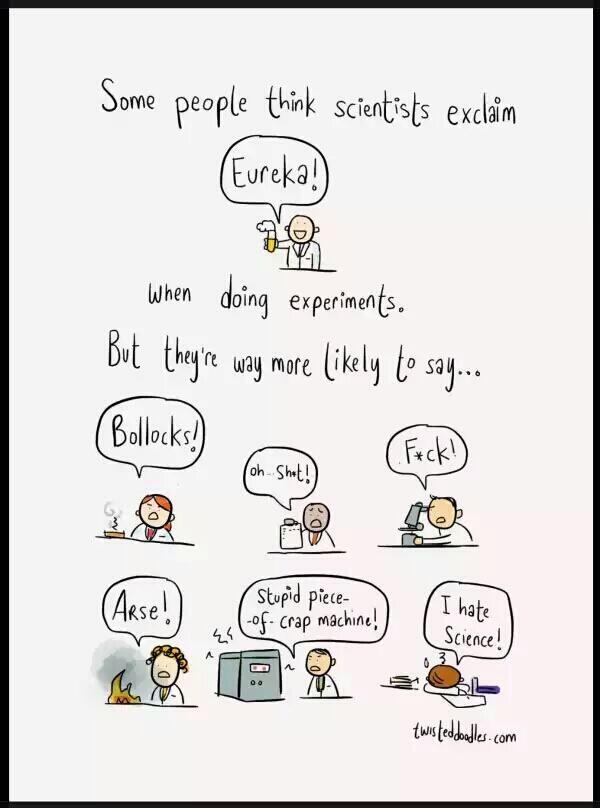Since there have been a few heated exchanges between people I’ve both grown to like and respect, I thought it was time for some light-hearted relief. I have a sense that some (not those who regularly comment here of course 🙂 ) have a rather simplistic view of how science actually works. They think that you design your experiment; you collect your data; you analyse your data using procedures that you specified before the project started; you don’t deviate from your original plan/strategy; you publish everything, warts and all.
There are areas where that may be close to how it works (or should work) but there are others where it is a far too simple perception of how science really works. The illustration below is much closer to actual scientific reality (cartoon from Twisted Doodles).


have been there (all 6) and could add a few 😉 !
Then moved into IT/Telco world.. and could add a whole lot more……..
As someone doing experiments at the moment…”oh, for f&*%@ sake!”
This reminds me of this little gem:
http://www.buzzfeed.com/kmallikarjuna/how-to-science-as-told-by-17-overly-honest-scientists
Science is messy, and the most interesting discoveries are made when someone says “hm, that’s odd.”
Now lets wait and see how soon someone will misrepresent what you said here into you saying that science can’t be trusted. 😉
I patented an accurate measurement technique, which had several decades improvement in accuracy, linearity and repeatability. Other companies had spent millions trying to get a small piece of that capability. (This was like, 2 lines of code to boot.)
My experience was the opposite, “Yes! That’s it!”
The slander came from other people in the oil and gas industry who didn’t believe that accurate measurements were possible. It had been codified in EPA regulations inaccurately some 30 years before. Industry error margins were specified ‘on full scale’. And they tended to make ‘full scale’ really really high.
Anders –
W/r/t previous discussions of natural variability vs. forcing mechanisms, I thought you might find this comment of interest:
http://climatechangenationalforum.org/your-logic-escapes-me-by-john-nielsen-gammon/?fb_comment_id=fbc_1441367616093022_216690_1442735225956261
Comment from Fred Moolton: 1/26 3:35 pm
Joshua,
Thanks. I’ll have to read that more carefully later. Seems interesting, but am not quite following the logic at this stage. Another coffee may help 🙂
Hilarious, although my experience was more like “I don’t have a clue what’s going on here”.
There was always that anxious moment when you get the p value back from Minitab, that was the real cartoon No5 moment, swiftly followed by No6.
Related:
Willard – yes, very good.
AAshleySharp, imposter syndrome isn’t something I haven’t touched on here, but I think it is much more prevalent than many realise. It’s interesting how pseudo-skeptics, many of whom have never published a scientific paper or actually done any real scientific research, are much more confident about their scientific views than those who actually do science.
Pingback: January top climate sites & articles from uClimate.com | ScottishSceptic
Pingback: Another Week in the Ecological Crisis – February 2, 2014 – A Few Things Ill Considered
Pingback: Science – wmconnolley: scienceblogs.com/stoat archive